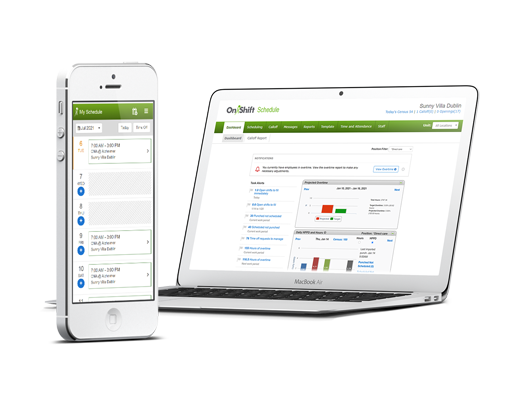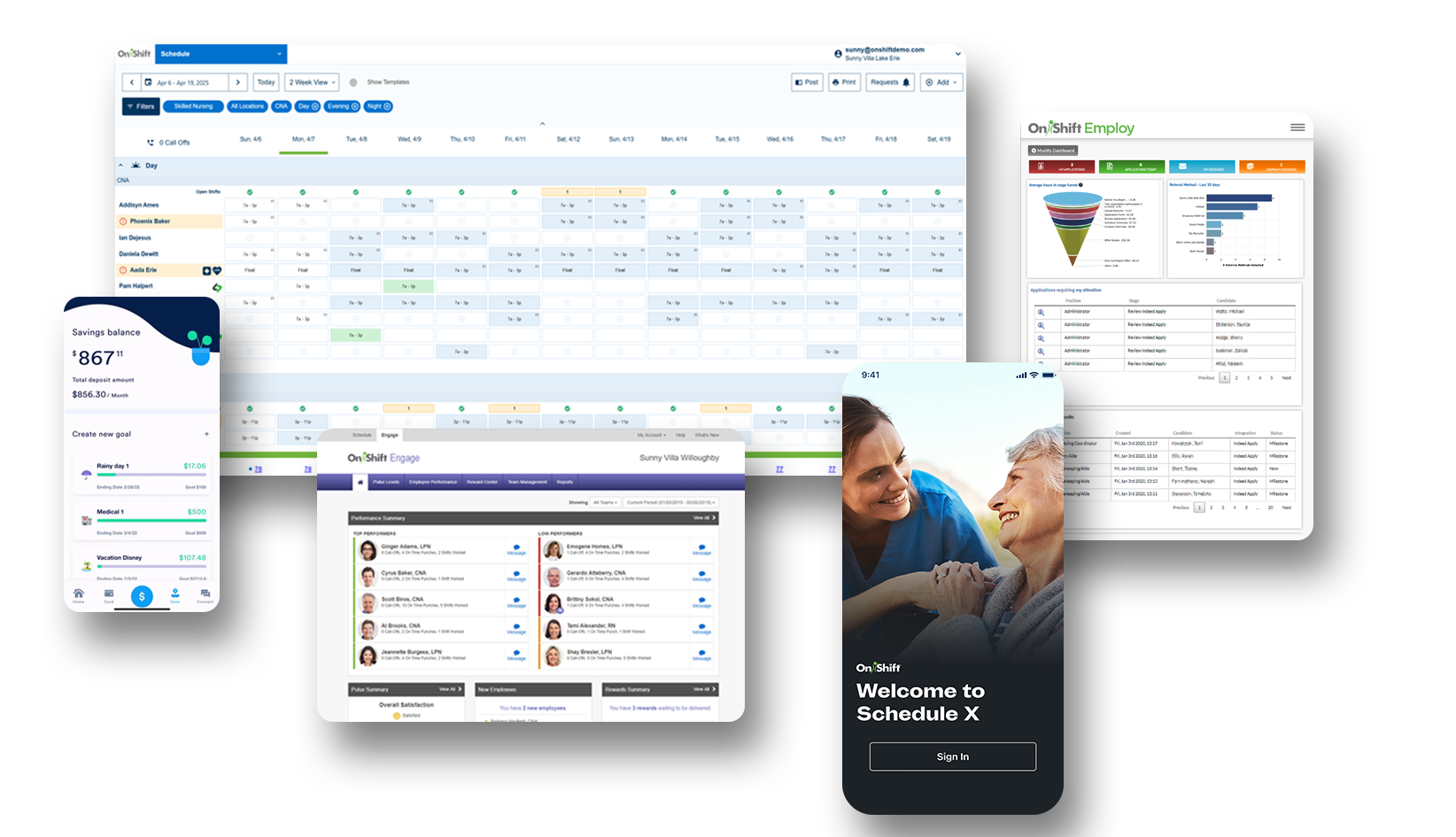

Staffing in long-term care and senior living is critical to the overall success of an organization. Unfortunately, the growing workforce shortage, high competition for talent both in and outside the industry, wage pressures and ever-changing staff reporting mandates have made staffing in senior care more complex than ever before.
The following workforce management best practices are proven to help long-term care and senior living providers increase efficiencies, reduce excess labor costs and boost staff satisfaction and engagement, all while ensuring providers are staffed consistently for quality care and service.
According to a recent survey of long-term care and senior living providers, 79% cited staffing shortages as their organization's top workforce challenge, followed by finding and hiring qualified job candidates and employee turnover.
The impact of the pandemic is still being felt across the senior care industry. And with a projected 2.5 million more workers needed to keep up with the nation's aging populations, providers are constantly challenged with having to do more with less staff to meet their daily requirements.
While ramping up efforts around recruitment, hiring and retention can and will help, those efforts can only go so far if you aren't taking advantage of opportunities to optimize staffing and maximize your workforce.
Utilization measures staff members' true availability compared to the hours they are scheduled or worked.
For example, a part time employee who is available to work 24 hours per week but is only working 16 hours per week would be considered underutilized at 67%. Conversely, an employee who has a full-time hourly threshold of 40 hours, but is working 48 hours would be considered overutilized at 120%.
Employees who are overutilized at a high frequency could be at risk for burnout and should therefore be monitored closely. In turn, those who are underutilized could potentially fill existing gaps in your schedule—instead of relying on overtime or excess shift pick-up bonuses.
Monitoring utilization on a weekly basis is the first step in right sizing your staff and maximizing your hiring efforts.
Gaps in your schedule may represent the biggest risk to providing
Ensuring quality care starts with establishing labor budget targets. Set an hours per patient day (HPPD) goal for each care position and use this information to drive staffing requirements for each shift. For an added layer of staffing compliance, establish minimum acceptable staffing levels. Management and schedulers should have real-time visibility into this data and know exactly what holes need to be filled to hit your daily staffing goals.
It is important to have staffing requirements set for each shift based on census and resident/patient acuity and/or service levels. As those factors fluctuate, staffing plans should as well. To get a full understanding of staffing needs, it is important to not only examine open shifts in your master schedule but also those that could be created by fluctuations in census and acuity/service.
When there is ongoing overtime and bonus incentives being used, there is also likely a gap in your schedule. Map the overtime and pick-up bonuses to specific shifts to determine if a pattern exists. If so, consider those gaps as shifts that need to be permanently filled.
Watch the video to hear how Touchstone Communities is using OnShift to manager labor costs & reduce overtime.
Like overtime and premium pay reliance, providers should document and analyze call-offs by employee and shift to determine if there is a recurring pattern. For example, trends might develop where an employee tends to call off the Friday after pay day. If a pattern like this exists, it's important to get to the root of the cause and re-assign that shift accordingly. In some cases, a pattern of call-offs can be a sign of low engagement. In others, it could be that the employee is no longer available for that shift and the scheduler has not yet made the appropriate adjustments. Either way, this pattern has created an additional scheduling gap and should be treated accordingly.
RECOMMENDED READING: Learn the metrics every senior care operator must include in their KPI scorecard to ensure success. DOWNLOAD NOW.
How well are your processes for recruiting, hiring, managing and engaging your employees working for your organization? Complete the quiz to find out!

Today's workforce values flexibility and working for organizations that help them best meet their preferred work-life balance. With the rise in gig economy ventures, offering more part-time or per diem opportunities can be a great hiring draw. It can also ensure you have a well-balanced staffing mix that provides cost savings, greater flexibility in staff scheduling and consistency for quality care and service.
Some providers staff full-time employees only, which can lead to significant cost overruns. Staffing emergencies such as call-offs or unplanned demand for more staff almost always put communities into overtime situations. The use of full-time staff may provide continuity of care, but it’s important to have some part-time staff in your mix for flexibility and cost control.
With the availability of part-time and per diem employees, providers can easily fill open shifts while controlling overtime. Consider times during the year that regularly require additional staff and leverage your part-time and per diem pool to fill these needs, scheduling them in advance. With a well-balanced mix of full-time, part-time and per diem employees, senior care organizations gain greater flexibility to cover open shifts and avoid overtime so they can more effectively balance costs.
Once staffing gaps have been identified you’ll need to hire new staff members to fill the remaining shifts.
With long-term care and senior living providers citing ongoing hiring and retention issues, many are looking to maximize their internal staff by either sharing staff across roles, departments or even nearby communities. Others are expanding this concept by creating their own internal staffing pool or travel team.
The first step in sharing employees across your organization is to identify staff members that are able and willing to work across multiple settings. For a single community, this would mean establishing a universal worker roles in which an employee would work within different roles or departments. For example, you may have a CNA who also has experience as a server and could therefore work in dining.
Providers with multiple communities should look for staff who are willing to occasionally travel to nearby communities based on demand or resident need. Staff could be shared with one or two additional communities or several. It really depends on the size of your organization and how far employees are willing to travel.
Regardless of how providers are sharing, it's important that employees can easily view and request open shifts across those shared positions, units or locations. This can help maximize the use of your shared employees and provide maximum control over their schedule.
Also known as internal agencies, float teams, flex teams or travel teams, no matter what you call it, an internal staffing pool is a great way to ensure gaps are filled consistently across your schedule.
While some providers utilize existing employees to join their staffing pool, many are hiring from scratch--creating an entirely new role and employee experience along the way.
Regardless of the approach, these internal agencies are comprised of employees that can be scheduled to work in a variety of locations, typically where demand is highest. They do not have a dedicated community that they report to. Instead, they report to a centralized manager who works with communities to place them where they are most needed. Most organizations offer the option of working full-time, part-time or per diem.
Staffing pools are a growing trend, and with good reason! This strategy can help providers dramatically reduce excess overtime and the need for last-minute shift bonuses to fill shifts.
Nothing is more important to achieving your staffing goals than the daily management of schedules.
Today’s senior care residents have more complex care needs, with an average of 2-3 activities of daily living (ADLs) in a senior living community and 4.21 ADLs in a long-term care facility. It’s no wonder that due to the increase in resident acuity levels, it’s often said that today’s assisted living organization is like yesterday’s skilled nursing community and today’s skilled nursing community is like yesterday’s hospital.
Schedulers should evaluate census/occupancy daily, not looking just at the current day, but what is anticipated in the days to come. By evaluating near-term census/occupancy in advance, schedulers can make appropriate staff adjustments to better align with planned move-ins/outs and admissions/discharges. For a short-stay population, consider creating a policy to ensure that staffing levels are checked and potentially modified daily or every shift.
Make staffing adjustments not only based on census/occupancy, but also on resident acuity. When resident acuity or service needs escalate, consider redeploying staff or adding staff to ensure resident needs are met. When resident acuity levels dip, this might present the opportunity to reduce staffing hours while still providing
In addition, it’s important to pay close attention to the activities of staff members. Family meetings, staff in-services, resident outings or unexpected admissions can consume more time than anticipated, taking caregivers away from providing direct resident care. To minimize impact, create a policy that manages these activities like employee absences or call-offs.
Watch the video to hear how Altercare saved on labor costs with better staffing visibility.
Consistently staffing to levels that meet residents’ needs, without overstaffing, can drive significant savings. For example, a 100-bed community that overstaffs by 0.1 hours per patient day can save $75,600/year with tighter staffing level alignment. This is another reason proactive labor budget management is critical to an organization’s success.
PBJ reporting mandates are extremely important for skilled nursing providers, particularly as it drives your Five-Star Staffing rating. To ensure you receive credit for the resident care you provide, a process to document, track and verify staffing must be established. This includes care provided from employees (both salaried and hourly), as well as contracted and agency hours.
Staffing in senior care can be hectic. And unfortunately, not all scheduling software is built to meet the unique and often complex needs of the industry. Learn the features and functionality to look for when evaluating scheduling and labor management software.

Many of the outdated practices of managing open shifts in senior care must end. Calling down a list until you find a replacement is both inefficient and ineffective. And relying on a select "go-to" employees to call on every time there is an opening can lead to excess overtime, burnout and leave an impression of favoritism.
For the best results, long-term care and senior living providers should implement an open shift management process that is both equal and open. In other words, cast the widest net possible by notifying all available and eligible staff members of open shifts as they happen. Doing so, will increase your chances of receiving a response and filling that shift without incurring potential overtime. Additionally, it works to keep staff engaged and feeling involved in the scheduling process.
Schedulers should always track responses to open shift requests, as well as the shift recipient. This is important for two reasons:
Ineffective call-off management can lead to excess labor costs, as overtime implications are often not considered in a rush to fill the shift. To combat this, make sure schedulers have visibility into how many hours each staff member is anticipated to work. Then, prioritize assignment of shifts based on each employee's risk for incurring overtime.
Modern scheduling software can help take some of the guess work out of assigning the most cost-effective choice to the shift. Look for scheduling software that offers visibility into overtime, as well as the ability to automatically approve shifts for those not at risk of overtime.
While there are numerous ways to reduce costs, careful attention should be paid to your largest expense–labor–which is typically 50-70% of a provider’s operating expense. Managing employee punch overages and overtime are two of the easiest ways to realize immediate savings.
Every day, employees clock in and clock out for proper record keeping and payroll management. But when employees start to clock in early and out late, additional minutes add up.
In the past, best practice for reducing excess overtime was to eliminate it from any master schedules or templates. But given current staffing challenges, providers are now building overtime into their schedule. Doing so can help them not only anticipate overtime costs, but reduce the need for costly shift pick-up bonuses.
Before adding overtime to the schedule, make sure you're fully utilizing your staff. Then work with your employees to identify who would like to take on additional hours to fill any remaining gaps.
RECOMMENDED RESOURCE: Learn more about the most common types of overtime in senior care, including what to embrace and what to avoid. READ MORE.

This overtime is built right into the staff schedule and recently has become a great way to combat excess shift pick-up bonuses. But it can also signal a potential hiring need or potential oversight during schedule creation and management. If you are building overtime into your schedule, make sure it's intentional. Otherwise, it could end up costing you.

This form of overtime occurs when employees punch in early and punch out late. While a common source of excess labor costs, it adds up a little bit at a time and can be difficult to identify and control. When done intentionally it is known as clock-riding and is one of the most common types of time theft.
.png)
This overtime happens when a nurse calls in sick or a CNA does not show up for a scheduled shift. It can also occur when a staff member has an unexpected change in their workload, typically a resident care need. These staffing emergencies are the most common and most visible type of overtime.
According to the American Payroll Association (APA), 75% of all businesses are affected by what’s known as time theft. The most common types of time theft include clock-riding, in which an employee clocks in a few minutes early and/or a few minutes late to earn a few extra dollars; and buddy punching, in which an employee asks a fellow co-worker to clock in for them, something nearly 23% of employees admit to doing.
While it may seem innocent enough for employees to add a few extra minutes at the start and end of their shift, the cost implications for providers can be staggering. By monitoring punches in real-time, providers can quickly spot potential clock-riding and address the issue quickly before it become a habit.
Additionally, biometric timekeeping systems, that utilize something like a fingerprint or iris scan can help greatly reduce buddy punching, but not always. To completely eliminate it, look for a time and attendance software that offers facial recognition biometrics. These systems utilize AI to learn the spatial coordinates of an employee's face to improve biometric score and reduce exception management. And because it is the only visually auditable biometric available on the market today, it has the ability to completely eliminate buddy punching.
Set overtime goals and make sure community leaders manage overtime each day, equipped with visibility into incurred and upcoming overtime across their properties. In addition, community leaders should establish policies for managing staff absences and call-offs, so schedulers go to non-overtime employees first to fill the gaps.
Finally, set policies that require management approval to incur overtime. Track and report on overtime goals, rates and costs. Proactively managing overtime will help keep labor costs under control and drive significant savings through overtime reduction. For example, just a 1% cut in overtime can save a community $24,000 - $60,000 annually (depending on community size). Collectively, these steps will help control costs and promote adherence to the labor budget, while still maintaining quality care, service and resident satisfaction.
Gaining visibility into key staffing events and metrics is critical to success. Labor is a community’s largest expense and one of the strongest determinants of quality for an organization. Easily understanding labor management costs, risks and performance within and across communities, in real-time, is the conduit to making better, more informed decisions that enhance your organization on a day-to-day basis.
To be effective, actionable staffing information must be available at your fingertips. Start by combining staffing metrics from multiple systems, including time clocks, payroll, HR, clinical and scheduling systems. This can ensure you have a full view of your workforce.
Keep in mind that decisions based on the last pay period or even yesterday’s data will fall short in helping you achieve objectives. Providers need insight and analysis into staffing needs to be predictive and proactive. Work to implement processes where management can be alerted before staffing risks occur, so teams have time to course correct.
A predictive approach can help avoid unnecessary labor costs, as well as mitigate staffing risks that could lead to perceived negligence and potential litigation.
Staff scheduling and labor management software can help focus your daily efforts with predictive analysis and real-time data that provides a 360° view into organizational performance by compiling information from disparate sources and systems.
What’s measured is managed. And for senior care, what’s measured is also what drive operational success. Get a breakdown of the labor metrics senior care operators need in their KPI scorecard to ensure success.

Ask most long-term care and senior living operators what their biggest concerns are and they often mention employee engagement as top on their list.
This is because research shows an engaged workforce is one of the most powerful and cost effective ways to improve productivity, reduce turnover and increase profitability.
Watch the video to learn how to engage employees with better work-life balance.
While engagement and retention strategies can go in many directions, there are a few key tips for executive directors and community managers that will make employees happier and your organization more successful.
Start by paying closer attention to your schedules and scheduling practices. Encourage employees to engage in the process. Find out what their preferences are – desired days, shifts and locations, time-off requests, etc. Also, schedulers must communicate changes clearly, share extra shifts equitably and make schedules visible and accessible, thereby promoting fairness and openness among staff.
When would you prefer to work? It's a simple question that, when answered, can help dramatically reduce call-offs and no shows. Work with your employees and new hires to understand what days and shift times they prefer to work. Once preferences are identified, do your best to balance these requests with the needs of the organization. It’s unlikely that staff will get 100% of their requests, but showing that you are listening and attempting to meet their scheduling needs will not go unnoticed.
While schedules may need to occasionally change due to fluctuations in occupancy or resident needs, being able to provide each employee with some consistency in their schedule can help improve overall staff satisfaction and engagement. It takes the guesswork out of their expected income and allows them to plan their life outside of work. This consistent assignment is also beneficial for residents and is often associated with higher levels of care and service. It also gives employees a fair chance to cultivate meaningful relationships with their residents, boosting overall job satisfaction.
Given the current staffing challenges senior care providers face, it’s hard to say ‘no’ when an employee can only work certain days, times or shift lengths. Consider implementing more flexible scheduling options by allowing employees to work part of a shift, or offering flexible shift times. This could include offering shorter shifts of 2- to 4-hours. For others it could mean working 12-hour shifts vs. 8-hour. Work with your employees to see what is of most interest to them and work to accommodate where you can.
Everyone likes to be recognized for a job well done. Boost engagement and motivate staff by recognizing and rewarding employees for positive behaviors such as not calling off, filling an open shift, punching in/out on time and going above and beyond the call of duty.
Give employees a say in when they work by allowing them to view and request open shifts and instantly reply to call-offs. And rethink how you communicate. More and more, workers rely on text messages and mobile apps for instant communication.
Providing on-the-go schedule access can have a major impact on staff satisfaction. Implementing scheduling software like OnShift gets everyone on the same page with access to schedules through the web and mobile apps. With real-time visibility into schedules, you can eliminate phone tag with employees and get your shifts filled quickly and efficiently.
“OnShift has been a hit among staff. They are smiling more. This is apparent to other employees, our residents and their families"
Ben Thompson, Executive Vice President
Senior Living Communities
Scheduling using pen and paper or one-size-fits-all scheduling software in long-term care and senior living comes with a lot of:
Watch the video to hear how OnShift is helping Next Step Healthcare make effective and efficient staffing decisions.
Manual scheduling makes measurement and goal alignment very difficult. If schedules are in spreadsheets or hand-written papers, and punch data is contained in time clocks, it’s difficult—if not impossible—for a community to be able to predict or manage overtime proactively. Integrating schedule data with time clock and census data will give you the information required to stay on top of staffing issues, meet regulatory standards and control costs.
Give your schedulers the appropriate tools and systems to help make them successful. Consider an automated approach to scheduling to drive efficiencies, and free up your employees so they have more time to do what they do best – provide quality care and service. Leveraging workforce management software built for senior care allows providers to eliminate inherent scheduling complexities and reduce time spent on scheduling from days and hours to just minutes.
But be wary of generic scheduling software that is built for the masses. These industry agnostic systems typically aren't developed with the unique staffing challenges of the senior care industry in mind. Look for a vendor partner who understands staffing long-term care and senior living and can provide the ongoing support and coaching your organization needs to optimize staffing and maximize your investment.
See for yourself why thousands of providers rely on OnShift’s innovative software for recruitment, hiring, workforce management, pay and engagement. Request your personalized demo today.
